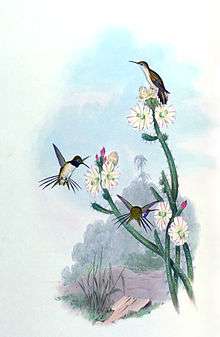Chilean woodstar
The Chilean woodstar (Eulidia yarrellii) is a small bird in the hummingbird family, Trochilidae. It is restricted to northernmost Chile with reports from southern Peru. Its natural habitats are dry shrubland and rural gardens. It is threatened by habitat loss and is classed as a critically endangered species. It is usually classified in its own genus Eulidia, but is sometimes placed with the purple-collared woodstar in the genus Myrtis. In 2013, it was classed as endangered, but recently, it was classed as critically endangered by the IUCN Red List.
| Chilean woodstar | |
|---|---|
 | |
| Scientific classification | |
| Kingdom: | Animalia |
| Phylum: | Chordata |
| Class: | Aves |
| Order: | Apodiformes |
| Family: | Trochilidae |
| Genus: | Eulidia Mulsant, 1877 |
| Species: | E. yarrellii |
| Binomial name | |
| Eulidia yarrellii (Bourcier, 1847) | |
| Synonyms | |
|
Myrtis yarrellii | |
Description
It is the smallest bird in Chile,[2] 7.2 to 7.5 cm long with the bill accounting for 1.5 cm of this.[3] The bill is black, straight, slender, and fairly short, about the same length as the head. The tail is often held in a cocked position.
The adult male is iridescent green above and whitish below with green sides. The throat is reddish-purple and blue, but often appears blackish. The tail is long, black, and forked, with long, pointed outer feathers that curve inwards. Females are green above and have a white throat, while the rest of the underparts are mostly very pale buff, darkest on the belly and thighs. The tail is short and slightly graduated with green inner feathers. The outer feathers are black with a rufous base and white tips. Immature males are similar to the female, but have a mottled throat and may have elongated outer tail feathers.[4]
The Peruvian sheartail is similar, but the male has two elongated white feathers in its tail, while the female tends to have a whiter belly and more buff throat than the woodstar. The tail is rarely cocked, but is frequently pumped vigorously up and down unlike the woodstar.[4]
The call is a series of rasping notes, quieter and less musical than the call of the Peruvian sheartail.[3] The male has a high-pitched, buzzing display call.[4]
Distribution and habitat
It is currently known to breed only in the Azapa and Vitor valleys in Arica and Parinacota Region in far northern Chile. It formerly occurred in the Lluta River valley, but has not been found there during recent surveys. Also an old record was made from Antofagasta Province. In Peru, a number of sight records are from Tacna Region and possibly Moquegua Region, but the species has not been recorded recently.[5]
It inhabits scrub and thickets along river valleys within desert regions. It is mainly found lower than 750 m above sea level, but occasionally occurs above 2000 m. It prefers natural vegetation, feeding on native shrubs such as Geoffroea decorticans. It also occurs in gardens and fruit groves, feeding on the flowers of Lantana, Hibiscus and Citrus. It is a solitary feeder whose diet mainly consists of nectar.[5]
Status and conservation
The species has a small and declining population and a world range estimated at just <1,200 km2. Because of this, it is classed as endangered by Birdlife International. The population was estimated at 1,200 individuals in 2007 with 55% in the Azapa valley and 45% in the Vitor valley.[5]
Habitat loss is the main threat to the species, with only small patches of suitable native vegetation remaining. The effect of pesticides and competition with the Peruvian sheartail are possible threats, but this has not yet been proven. A species recovery plan was approved in 2004 which included plans for monitoring the population, restoring natural vegetation, studying competition with the Peruvian sheartail, and the possibility of reintroducing the birds in areas of their former range.[5]
References
- BirdLife International (2012). "Eulidia yarrellii". IUCN Red List of Threatened Species. 2012. Retrieved 26 November 2013.CS1 maint: ref=harv (link)
- Aves de Chile (1999-2008) Chilean Woodstar. Archived 2008-04-11 at the Wayback Machine Retrieved 2 July 2008.
- Schulenberg, Thomas S.; Stotz, Douglas F.; Lane, Daniel F.; O'Neill John P. & Parker, Theodore A. III (2007) Field Guide to the Birds of Peru, Christopher Helm, London. ISBN 978-0-7136-8673-9
- Jaramillo, Alvaro; Burke, Peter & Beadle, David (2003) Field Guide to the Birds of Chile, Christopher Helm, London. ISBN 0-7136-4688-8
- BirdLife International (2008) ["Archived copy". Archived from the original on 2007-07-10. Retrieved 2013-05-07.CS1 maint: archived copy as title (link)/datazone/species/index.html?action=SpcHTMDetails.asp&sid=2107&m=0 Species factsheet: Eulidia yarrellii.] Downloaded from "Archived copy". Archived from the original on 2007-07-10. Retrieved 2013-05-07.CS1 maint: archived copy as title (link) on 2 July 2008.
External links
- ARKive: Chilean woodstar (Eulidia yarrellii) — images and videos.
